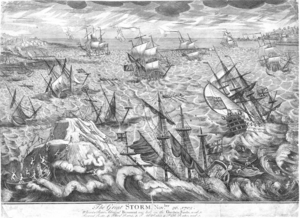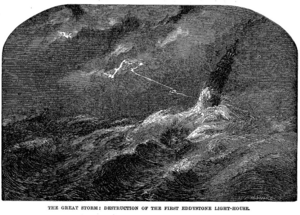Great storm of 1703 facts for kids

The Great Storm November 26, 1703 Wherein Rear Admiral Beaumont was lost on the Goodwin Sands... Beaumont's Squadron of Observation off Dunkerque
|
|
| Type | European windstorm, Extratropical cyclone, Winter storm |
|---|---|
| Formed | 7 December 1703 N.S. (26 November 1703 O.S.) |
| Dissipated | 10 December 1703 N.S. (29 November 1703 O.S.) |
| Total fatalities | >8,000 |
| Areas affected | England, Wales, Netherlands, France, Belgium, Germany |
The Great Storm of 1703 was a super powerful storm, like a huge extratropical cyclone, that hit central and southern England on November 26, 1703. This storm was so strong that it blew down about 2,000 chimney stacks in London alone! It also badly damaged the New Forest, where 4,000 oak trees were lost.
Many ships were pushed hundreds of miles off course by the winds. Over 1,000 sailors died just on the Goodwin Sands, a dangerous sandbank. Back then, news about how many people were hurt and how much damage was done was sold all over England, which was a new thing. Some people, like the Church of England, believed the storm was a sign of God's anger.
Contents
What Made the Storm So Strong?
Scientists who studied the storm later think it was as powerful as a Category 2 hurricane. This means it had incredibly strong winds, similar to the big hurricanes we hear about today.
When the storm hit, people measured the air pressure. It was very low, which usually means a very strong storm. One person measured it at 973 millibars. Experts now believe it might have been even lower, around 950 millibars, over the middle of England.
How Much Damage Did It Cause?
The Great Storm caused a lot of destruction across England and Wales.
Damage in London
In London, around 2,000 huge chimney stacks fell down. The lead roof of Westminster Abbey was ripped off. Even Queen Anne had to hide in a cellar at St James's Palace to stay safe from falling chimneys and parts of the roof.
On the River Thames, about 700 ships were piled up together. The river water rose 6 feet higher than ever before, destroying more than 5,000 homes along the riverbanks.
Damage Across the Country
Many famous buildings were damaged. For example, King's College Chapel in Cambridge lost its tall, pointy tops called pinnacles.
There was also a lot of flooding, especially in the West Country around Bristol. Hundreds of people drowned in the floods on the Somerset Levels. Thousands of sheep and cattle were also lost. One ship was even found 15 miles (24 km) inland!
About 400 windmills were destroyed. The wind spun their wooden gears so fast that some even caught fire! At Wells, the local bishop, Richard Kidder, and his wife were killed when chimneys fell on their house. Part of the big window in Wells Cathedral was also blown in. In Wales, the southwest tower of Llandaff Cathedral was badly damaged.
Damage at Sea
Many ships were wrecked at sea. Some were coming back from helping in the War of the Spanish Succession, a big war happening at the time. Several Royal Navy ships, like HMS Stirling Castle and HMS Northumberland, were lost on the Goodwin Sands. About 1,500 sailors died there.
Overall, between 8,000 and 15,000 people died because of the storm. Some reports say the number could be even higher. Around 300 Royal Navy ships along the south coast were lost. The first Eddystone Lighthouse off Plymouth was destroyed, and all six people inside, including its builder Henry Winstanley, were killed.
The towns of Plymouth, Hull, Cowes, Portsmouth, and Bristol were hit very hard. A group of 130 merchant ships and their escort warships were caught in the storm at Milford Haven. By the next afternoon, 30 of these ships were lost.
How People Reacted
The storm was so strong and lasted so long that many people thought it was a sign of God's anger. The government even declared January 19, 1704, a day of fasting, asking people to pray and reflect. For many years after, the storm was a common topic in religious talks.
The Storm in the News
The Great Storm happened when journalism was becoming more popular in England. It was the first big weather event to be reported across the whole country. Special newspapers were printed, sharing details about the damage and stories of those who died.
Daniel Defoe, a famous writer, wrote a whole book called The Storm in 1704. He described it as "the tempest that destroyed woods and forests all over England." He wrote that "No pen could describe it, nor tongue express it, nor thought conceive it." He said that coastal towns like Portsmouth looked like an enemy had attacked them. Defoe believed the destruction of the navy was a punishment for their poor performance against the French and Spanish armies in the war.

The Royal Navy was hit very hard by the storm. They lost 13 ships, including their entire Channel Squadron, and over 1,500 sailors drowned. Many ships were pushed onto the Goodwin Sands, a dangerous sandbank where ships often waited.
Some of the ships lost included:
- HMS Restoration: All 387 men on board were lost.
- HMS Northumberland: All 220 men were killed.
- HMS Stirling Castle: 206 men drowned, but 70 were saved.
- HMS Mary: Rear Admiral Beaumont and 268 men drowned. Only one man, Thomas Atkins, survived in an amazing way, being swept from one sinking ship to another before being rescued.
- HMS Resolution: Lost off Pevensey, but all 221 men were saved.
- HMS Newcastle: Lost at Spithead, with 193 men drowned.
- HMS Reserve: Lost off Great Yarmouth, with 175 men drowned.
- HMS Vanguard: Sunk in Chatham harbour, but it was not fully crewed at the time.
More than 40 merchant ships were also lost. Some historians believe as many as 10,000 sailors were lost in one night, which would be about a third of all the sailors in the Royal Navy at the time.
Date: Old Style
The date of November 26, 1703, is given using the Julian calendar, which was used back then. If we used today's Gregorian calendar, the date would be December 7.
See also
- Great storm of 1987
- List of disasters in Great Britain and Ireland by death toll
- United Kingdom weather records


